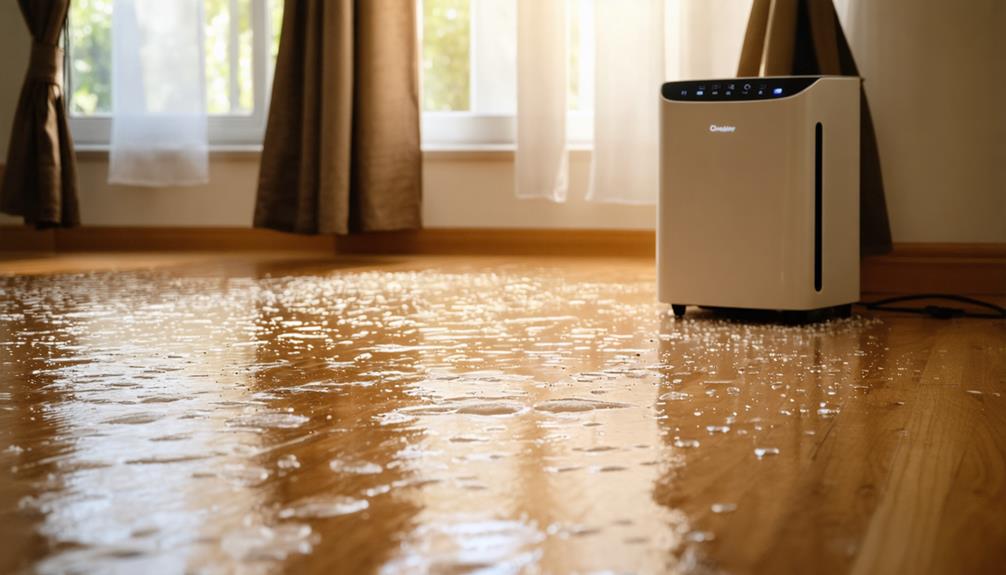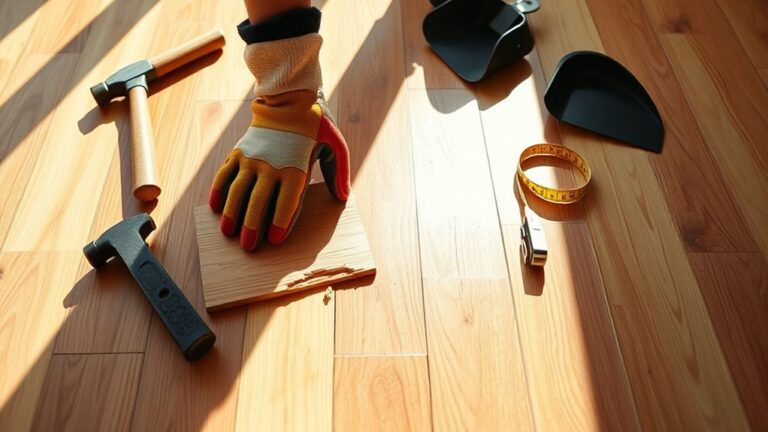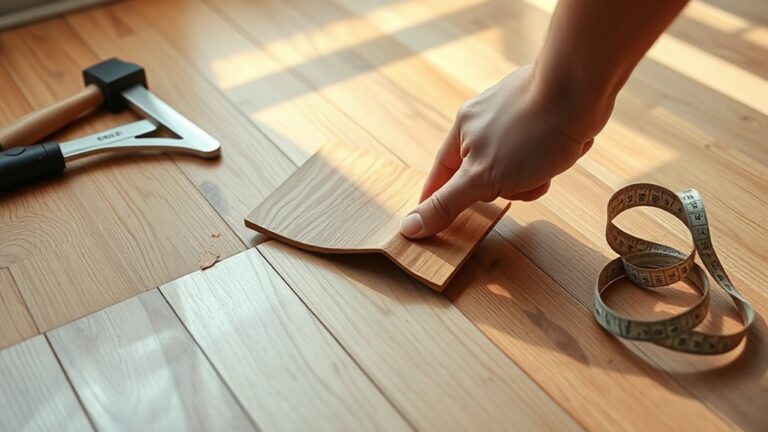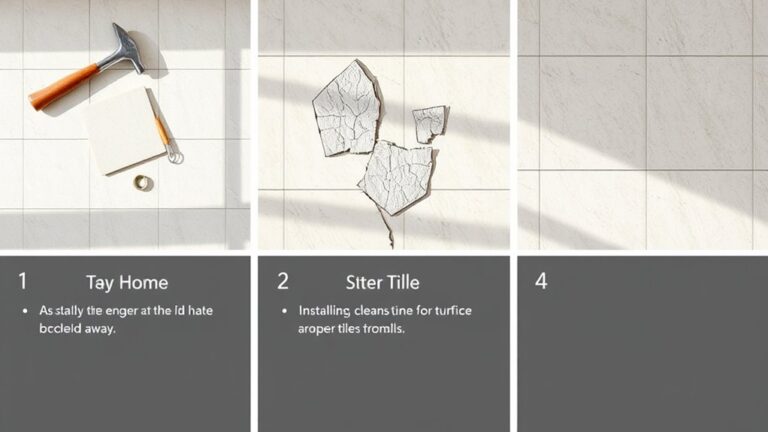To stop your floors from sweating, start by controlling humidity levels and improving airflow. Use dehumidifiers to reduce moisture in the air and consider installing high volume low speed fans to enhance circulation. Make sure your insulation is adequate and seal your concrete floors with moisture-blocking products. Adjust your HVAC settings to keep temperatures more uniform between your home's air and concrete surfaces. Regular maintenance, like monitoring humidity and inspecting insulation, also helps prevent sweating. Implementing these strategies can greatly mitigate condensation issues, and there's more to explore about effective long-term solutions.
Understanding Floor Sweating
Understanding floor sweating can be frustrating, especially when it leads to slippery surfaces and potential mold growth. This issue, often referred to as sweating slab syndrome (SSS), occurs when warm, moist air comes into contact with cooler concrete surfaces, causing condensation to form on your floors.
The phenomenon is closely tied to the dew point—the temperature at which air becomes saturated with moisture. If the temperature of your concrete slab is below the dew point of the surrounding air, condensation is inevitable. This situation is particularly common during humid nights or in spaces with high humidity levels, where temperature fluctuations can exacerbate the problem.
Additionally, poor insulation and inadequate air circulation can worsen sweating issues. When indoor air remains considerably warmer than the concrete surfaces, you're more likely to encounter condensation problems.
The consequences of sweating floors aren't just inconvenient; they can lead to slippery conditions, promote mold and mildew growth, damage flooring materials, and increase maintenance costs. It's essential to understand these aspects to address the issue effectively.
Causes of Floor Sweating
Floor sweating happens mainly due to temperature and humidity effects, where warm air hits cooler surfaces. Poor insulation and insufficient airflow can worsen this issue, making it important to address these factors. Additionally, moisture from beneath the floor slab can contribute to the problem, indicating potential drainage issues.
Temperature and Humidity Effects
Humidity and temperature play an essential role in causing floor sweating. When warm, humid air meets cooler floor surfaces, condensation occurs. This is especially common in spaces with high humidity levels and poor insulation. If the floor temperature drops below the dew point of the surrounding air, you're likely to see moisture forming. Here are some key factors to take into account:
- Temperature Fluctuations: Rapid temperature changes, like humid nights followed by cooler mornings, can exacerbate sweating. The air cools faster than the concrete, leading to condensation.
- Humidity Levels: Maintaining indoor humidity below 60% can greatly reduce the risk of floor sweating. Monitor your humidity levels regularly.
- Stagnant Air: Lack of adequate air circulation can intensify condensation. Stagnant air traps moisture, preventing it from dissipating.
- Dew Point Awareness: Understand the dew point in your environment. If the floor temperature dips below this point, you're at risk for condensation.
Insulation and Airflow Issues
Inadequate insulation and poor airflow can greatly contribute to floor sweating issues. When insulation is insufficient, temperature differences arise between warm air and cooler concrete surfaces, leading to condensation. Similarly, stagnant warm, moist air near cooler floors can amplify sweating problems. Seasonal fluctuations also play a role, as rapid cooling of concrete surfaces encourages condensation when warm air contacts them.
To illustrate the key issues related to insulation and airflow, consider the following table:
| Issue | Impact on Sweating | Solutions |
|---|---|---|
| Insufficient insulation | Creates temperature differences | Upgrade insulation |
| Poor airflow | Stagnates warm, moist air | Improve ventilation |
| Rapid temperature changes | Increases condensation risk | Use thermal barriers |
| Lack of ventilation | Traps moisture | Open windows or vents |
| High humidity | Promotes condensation | Use dehumidifiers |
Addressing these insulation and airflow issues is essential for reducing floor sweating. By ensuring proper insulation and enhancing airflow, you can create a balanced indoor environment, reducing the likelihood of condensation and keeping your floors dry.
Problems Associated With Sweating Floors
Sweating floors can create serious safety hazards, making surfaces slippery and increasing the risk of accidents. Additionally, the persistent moisture can promote mold and mildew growth, which not only damages your flooring but also poses health risks. It's essential to address these issues promptly to protect both your home and your well-being.
Safety Hazards From Slippage
When you walk into a room with moisture-laden floors, you might not realize the hidden dangers lurking beneath your feet. Sweating floors can create dangerously slippery surfaces, increasing the risk of falls and injuries, especially in high-traffic areas. The presence of moisture can lead to hazardous conditions, particularly when combined with foot traffic or wheeled equipment.
Here are some key safety hazards associated with sweating floors:
- Increased Fall Risk: Slip and fall incidents contribute to over 1 million emergency room visits annually, often linked to wet surfaces.
- Injury Severity: Falls can lead to serious injuries, including fractures and concussions, affecting both individuals and productivity.
- Maintenance Costs: Prolonged moisture exposure necessitates increased cleaning efforts and repairs, impacting your budget.
- Operational Disruption: Safety hazards can lead to work stoppages or decreased efficiency, disrupting your daily activities.
To maintain a safe environment, it's essential to address the causes of sweating floors. By doing so, you can minimize the risk of slips and falls, ensuring freedom of movement without worry.
Mold and Mildew Growth
Moisture-laden floors can quickly become a breeding ground for mold and mildew, posing serious risks to both your health and your home. When floors are sweating, they create an environment where these fungi thrive, especially if moisture isn't controlled. This can lead to poor indoor air quality, which is particularly harmful for anyone with respiratory issues.
You may notice unsightly water spots and stains as a result of mold growth, which not only detracts from your home's appearance but could also contribute to long-term damage. The presence of mold brings increased maintenance costs, as you'll need to invest time and money into remediation efforts to eliminate both the mold and the source of the moisture.
To prevent mold and mildew proliferation associated with sweating floors, it's essential to regularly monitor moisture levels. Taking immediate action when you spot signs of sweating can save you from more significant problems down the line. By staying vigilant, you can maintain a healthier living environment and avoid the headaches that come with mold and mildew in your home.
Damage to Flooring Materials
Persistent dampness beneath your feet can wreak havoc on various flooring materials. If you're experiencing a moisture issue, it's vital to understand how it can damage your floors. Here are some common problems associated with sweating floors:
- Laminate Damage: Excess humidity can cause laminate flooring to curl or warp, leading to costly replacements.
- Concrete Staining: Continuous condensation may create unsightly water spots that detract from your space's aesthetic appeal.
- Adhesive Weakening: Increased moisture levels can weaken the adhesives used in flooring installations, making tiles and planks prone to loosening or detaching.
- Health Risks: A damp environment encourages mold and mildew growth, posing health risks and potentially necessitating expensive remediation efforts.
Regular cleaning and maintenance may help, but they can also drive up upkeep costs and reduce the longevity of your flooring materials. To maintain your freedom in choosing beautiful flooring, addressing the root cause of sweating floors is imperative. Ignoring these issues could lead to significant and often irreversible damage, so act now to protect your investment.
Prevention Techniques
To effectively prevent floors from sweating, consider implementing several key techniques that address humidity and temperature control. Start by using high volume low speed (HVLS) fans. These fans improve air circulation, greatly reducing the likelihood of condensation forming on your floors.
Next, adjust your heating and air conditioning settings. Maintaining similar temperatures between the air and concrete surfaces helps prevent the cooling of the slab below the dew point, which is essential in keeping your floors dry.
Dehumidifiers are another necessary tool. They effectively extract moisture from the air, directly combating the root cause of floor sweating. Make sure you have a dehumidifier in areas prone to humidity, especially during warmer months.
Applying penetrating sealers is also important. Products like Siloxa-Tek 8510 block moisture ingress into concrete, greatly reducing the chances of condensation on surfaces. Before applying these sealers, consider using a concrete densifier as a primer. This step enhances moisture control, providing a more effective barrier against sweating.
Recommended Products and Solutions
Implementing effective prevention techniques is just the first step in keeping your floors dry; choosing the right products can make a notable difference. When dealing with moist air, selecting the appropriate solutions not only minimizes the risk of floor sweating but also contributes to a healthier living environment. Here are some recommended products:
- Lithi-Tek 4500: This concrete primer reduces porosity, limiting moisture absorption and preventing floor sweating effectively.
- Siloxa-Tek 8510: A penetrating, water-repellent sealer that creates a protective barrier against moisture, considerably reducing condensation on concrete surfaces.
- Chemically Reactive Concrete Densifiers: These products enhance moisture control by filling in pores within the concrete, making it less susceptible to sweating and surface condensation.
- Prompt Application of Sealers: Timely application is essential to prevent mold and mildew growth, which thrive in the damp environments created by sweating floors.
It's vital to consult specific product recommendations based on your project's unique needs for ideal results. By addressing the issues of moist air with these tailored solutions, you can notably reduce the chances of floor sweating, ensuring a comfortable and dry space. Remember, the right products are key in your fight against unwanted moisture.
Long-Term Maintenance Strategies
Maintaining a dry and comfortable environment over the long term requires a proactive approach to moisture control. Start by regularly monitoring your indoor humidity levels, aiming for a range between 30-50%. Keeping humidity in this zone helps minimize condensation on floors, reducing the risk of sweating. You should also keep an eye on the dew point, as it directly affects how moisture behaves in your space.
Schedule annual inspections of your insulation and sealants to prevent moisture ingress. Ensuring these elements are intact will help regulate temperature and keep your indoor environment stable. Your HVAC system plays an essential role too. Change filters regularly and schedule professional maintenance to promote effective airflow and temperature control.
Implementing a consistent cleaning routine is vital. Regularly remove moisture and debris from your floors to prevent mold and mildew growth, which can thrive in damp conditions. You might also consider investing in moisture-resistant flooring materials or protective coatings that can offer long-term resistance against the effects of concrete sweating.
Frequently Asked Questions
How Do You Fix Sweaty Floors?
To fix sweaty floors, you need to focus on sweat prevention. Start by increasing air circulation with fans and installing exhaust fans in humid areas. Use dehumidifiers to remove excess moisture from the air. Consider applying penetrating sealers to your floors, blocking moisture ingress. Don't forget to repair any leaks or cracks in your building's structure. Finally, monitor and adjust your HVAC system to maintain comfortable humidity levels for a more enjoyable space.
How Do I Stop Moisture From Coming Through the Floor?
To stop moisture from coming through the floor, you'll need to investigate your space thoroughly. Start by looking for leaks or cracks in the foundation. Next, consider installing moisture barriers, like polyethylene sheets, beneath your flooring to block moisture from rising. Using a dehumidifier can also help reduce indoor humidity. Finally, make certain good ventilation by using exhaust fans or opening windows, allowing fresh air to circulate and keep humidity levels in check.
How Do I Protect My Floor From Moisture?
To protect your floor from moisture, start with proper floor insulation. Insulating beneath your flooring reduces temperature differences that cause condensation. You might also consider applying a penetrating sealer, like Siloxa-Tek 8510, to create a moisture-repellent barrier. Regularly monitor indoor humidity levels and use dehumidifiers to keep moisture at bay. Enhancing air circulation with high volume low speed fans can further help in reducing moisture accumulation, keeping your floors safe and sound.
How Do You Fix Humid Floors?
Picture a summer day when the air's thick with humidity, and your floors feel like a sauna. To fix humid floors, start with humidity control. Use a dehumidifier to pull moisture from the air. Boost air circulation with fans to keep things moving and avoid stagnant spots. Check for leaks that might invite unwanted moisture, and consider applying a sealer to your floors. Insulating underneath can also help, keeping your space comfortable and dry.




